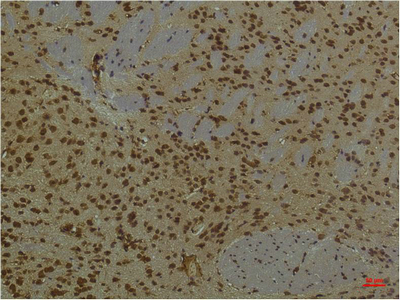HIF1 bata Monoclonal Antibody
For reference only. Please follow the manual included in your kit for instructions.
Catalog Number
RD85617A
Product Name
HIF1 bata Monoclonal Antibody
Catalog Number
RD85617A
Clonality
Monoclonal
Purification Method
Protein A purification
Isotype
IgG
Host
Mouse
Background
Hypoxia-inducible factor 1 (HIF1) is a heterodimeric transcription factor that plays a critical role in the cellular response to hypoxia (1). The HIF1 complex consists of two subunits, HIF-1α and HIF-1β, which are basic helix-loop-helix proteins of the PAS (Per, ARNT, Sim) family (2). HIF1 regulates the transcription of a broad range of genes that facilitate responses to the hypoxic environment, including genes regulating angiogenesis, erythropoiesis, cell cycle, metabolism and apoptosis. The widely expressed HIF-1α is typically degraded rapidly in normoxic cells by the ubiquitin/proteasomal pathway. Under normoxic conditions, HIF-1α is proline hydroxylated leading to a conformational change that promotes binding to the von Hippel Lindau protein (VLH) E3 ligase complex; ubiquitination and proteasomal degradation follows (3,4). Both hypoxic conditions and chemical hydroxylase inhibitors (such as desferrioxamine and cobalt) inhibit HIF-1α degradation and lead to its stabilization. In addition, HIF-1α can be induced in an oxygen-independent manner by various cytokines through the PI3K-AKT-mTOR pathway (5-7).HIF-1β is also known as AhR nuclear translocator (ARNT) due to its ability to partner with the aryl hydrocarbon receptor (AhR) to form a heterodimeric transcription factor complex (8). Together with AhR, HIF-1β plays an important role in xenobiotics metabolism (8).
Immunogen Information
Immunogen
Recombinant Protein
Swissprot
P27540
Synonyms
arnTARNT proteinARNTAryl hydrocarbon receptor nuclear translocatorbHLHe2Class E basic helix-loop-helix protein 2Dioxin receptorDioxin receptor nuclear translocatorDrntHIF 1 betaHIF 1betaHIF-1-betaHIF1-betaHIF1BHIF1betaHypoxia Inducible Fact
Observed MW
87 kDa
Applications
Reactivity
Mouse
Tested Applications
WB,IHC-p,IF
Conjugation
Unconjugated
Dilution
WB 1:1000-2000, IHC 1:100-200
Concentration
1 mg/mL
Storage Buffer
PBS with 0.02% sodium azide, 0.5% protective protein and 50% glycerol, pH7.4
Storage Instructions
Store at -20°C. Avoid freeze / thaw cycles.

